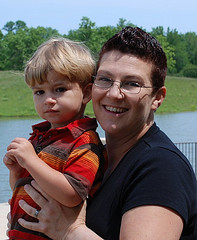By Jan Hunt, founder/director of The Natural Child Project, www.naturalchild.org
 It’s always a dilemma for me to know just how to address the subject of substitute care, because there is such a gap in our culture between the ideal and the possible. Ideally, there would be little need to use substitute care, nor would any mother feel a strong personal need or desire to do so. The reality, of course, is that parenting — the most important job a woman can have — is not valued sufficiently.
It’s always a dilemma for me to know just how to address the subject of substitute care, because there is such a gap in our culture between the ideal and the possible. Ideally, there would be little need to use substitute care, nor would any mother feel a strong personal need or desire to do so. The reality, of course, is that parenting — the most important job a woman can have — is not valued sufficiently.
No one should ever feel that she is “only a mother” — motherhood should be more highly valued than any other profession. No other job is as critically important; no other job has the potential for improving our world by nurturing the capacity to love and trust others. As Canadian psychiatrist Elliott Barker wrote: “We have to change a lot of established patterns or ways we do things — our priorities — so that nothing gets in the way of attachment in the earliest years. The capacities for trust, empathy, and affection are in fact the central core of what it means to be human, and are indispensable for adults to be able to form lasting, mutually satisfying cooperative relationships with others.”
Our culture not only minimizes the importance of motherhood, it maximizes the desire to consume commercial products, defining success always in economic, rarely in humane or social, terms. There is no question that a mother with a professional career who uses daycare for her children receives far more recognition and respect than the mother who has left a professional job to stay at home with her children — despite the fact that the at-home mom is in a position to contribute far more to society in the long term. If motherhood was valued as highly as it should be, more mothers would choose to stay at home, and more pressure would be put on governments to help provide the means by which this could be done.
Creative solutions can only come about through a deeply-felt need. If everyone understood the critical importance of mothering, there would be fewer daycares and more and better alternative solutions that keep mother and child together. There would be more family centers where mothers with infants and young children could get together with other parents, watching the children as they play together. Families would be given sufficient financial support by the government, and this support would be seen not as a “handout” with all the stigma that welfare has now, but as a wise and critical investment in our future. Everyone would know that motherhood is the single most important profession there is, one that deserves the highest esteem and the highest pay. What kind of society do we have where athletes, movie stars, and CEOs get the highest pay? What kind of society do we have when the professional woman with her children away from her all day enjoys higher esteem than the stay-at-home mother who has the opportunity to nurture a human being, whose personal qualities, positive or negative, will affect all future relationships? Which is the more critical job?
Our vision is too narrow, too immediate, too limited. We see only the present contribution of the professional woman and are blind to the even greater potential contribution of the mother at home. We need to value these mothers now — or our future will look no different than it does at present, with our myriad social problems.
If we really understood the importance of the mother-child bond, we would find those solutions that now seem so elusive and difficult. We would recognize that a young child who has bonded with a particular caregiver, who then disappears from the child’s world, can internalize feelings of rejection and disappointment. We would be committed to finding ways to keep mothers, babies, and young children together. We would provide whatever financial support is needed, and give extensive parenting education to all. We would give greater prestige and sufficient financial support to dedicated stay-at-home mothers. Most of all, we would recognize that repeated separations from the mother can damage the mother-child relationship and create a tragic reluctance in the child to love and trust others in the future. Close bonds of love and trust take time to develop; they take time to maintain.
We would recognize the critical importance of providing paid maternity leave. We would understand that parental care has the most stability. We would build a healthier population and fewer hospitals and prisons. We would strive to learn more about the father-child bond, and give fathers an opportunity to bond early with their child, and to support the mother in the earliest years. We would enjoy a very different and vastly improved society, where compassion and connection were valued and desired more than any other goal or commodity, where a small house filled with love, trust and joy would be valued far higher than the biggest mansion.
What do you think? Weigh in on this Attachment Parenting International poll on the Value of Motherhood.
 By Kelly Bartlett, certified positive discipline educator and leader for East Portland API, Oregon USA
By Kelly Bartlett, certified positive discipline educator and leader for East Portland API, Oregon USA
 There are some things that simply drive us parents crazy: One is when your child insists on doing something that you want to do yourself. You are trying to feed your 1-year-old mashed potatoes and carrots, and he clamps his mouth shut while squashing the mixture through his fingers. You finally finish dressing your 3-year-old so you can make it on time to work, only to find that she has undressed herself 2 minutes later because she wants to do it herself. And as you are carefully unpacking the groceries, your 6-year-old silently volunteers to put the tray of 36 eggs into the refrigerator. (These examples are just for starters. I’m sure you’ll think of many more)!
There are some things that simply drive us parents crazy: One is when your child insists on doing something that you want to do yourself. You are trying to feed your 1-year-old mashed potatoes and carrots, and he clamps his mouth shut while squashing the mixture through his fingers. You finally finish dressing your 3-year-old so you can make it on time to work, only to find that she has undressed herself 2 minutes later because she wants to do it herself. And as you are carefully unpacking the groceries, your 6-year-old silently volunteers to put the tray of 36 eggs into the refrigerator. (These examples are just for starters. I’m sure you’ll think of many more)!
 How many of us arrived at Attachment Parenting because we wanted to parent differently than we were parented? I have had the (mis)fortune recently of witnessing exactly how I was parented. First my mom came to visit, then my dad. It’s hard to get the distance to observe our relationship objectively, but watching each of them with my son was illuminating.
How many of us arrived at Attachment Parenting because we wanted to parent differently than we were parented? I have had the (mis)fortune recently of witnessing exactly how I was parented. First my mom came to visit, then my dad. It’s hard to get the distance to observe our relationship objectively, but watching each of them with my son was illuminating. In the United States alone, there are 3.2 million referrals to social services on allegations of child maltreatment each year — one-quarter of which are found to have a substantiated case of physical or sexual abuse or severe neglect. Seventy-five percent of these founded cases of abuse or neglect had no prior history. It’s an astounding number of children who aren’t living in safe, loving homes — especially knowing that these numbers don’t count the abused and neglected children living around the world. It’s a number that child maltreatment prevention researcher David Zielinski, PhD, wants to stick in your mind.
In the United States alone, there are 3.2 million referrals to social services on allegations of child maltreatment each year — one-quarter of which are found to have a substantiated case of physical or sexual abuse or severe neglect. Seventy-five percent of these founded cases of abuse or neglect had no prior history. It’s an astounding number of children who aren’t living in safe, loving homes — especially knowing that these numbers don’t count the abused and neglected children living around the world. It’s a number that child maltreatment prevention researcher David Zielinski, PhD, wants to stick in your mind.